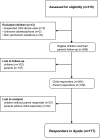Six years beyond pediatric trauma: child and parental ratings of children's health-related quality of life in relation to parental mental health
- PMID: 26001639
- PMCID: PMC4592698
- DOI: 10.1007/s11136-015-1002-y
Six years beyond pediatric trauma: child and parental ratings of children's health-related quality of life in relation to parental mental health
Abstract
Purpose: To examine the relationship between child self-report and parent proxy report of health-related quality of life (HRQL) and how parents' mental health status relates to the HRQL ratings 6 years after minor to severe injury of the child.
Materials and methods: This cross-sectional cohort study was performed at a regional pediatric trauma center in Stockholm, Sweden. The PedsQL 4.0 versions for ages 5-7, 8-12, and 13-18 years were completed by 177 child-parent dyads 6 years after injury to the child. The parents also rated their own mental health through the mental health domain (MH) in the SF-36 Health Survey.
Results: The children's median age was 13 years (IQR 10-16 years), 54 % were males, and the median ISS was 5 (IQR 2-9). Most of the parents were female (77 %), born in Sweden (79 %), and half had university degrees. There was no statistically significant difference between child self-report and parent proxy report in any of the PedsQL 4.0 scales or summary scales. The levels of agreement between child self-report and parent proxy reports were excellent (ICC ≥ 0.80) for all scales with the exception of emotional functioning (ICC 0.53) which also was the scale with the lowest internal consistency in child self-report (α 0.60). Multiple regression analyses showed that worse parental mental health status correlated with worse child self-report and parent proxy report of children's HRQL.
Conclusions: Children and their parents' reports on child's HRQL were in agreement. Decreased mental health in parents was associated with lower scores on parent proxy reports and child self-reports of HRQL after injury. The current investigation highlights the possible relationship between parent's mental health status and children's HRQL long after an injury, which should be considered in future investigations and in clinical care.
Keywords: Depression; Health-related quality of life; Injury; Mental health; Parents; Pediatric; PedsQL; Trauma.
Similar articles
-
Factors influencing agreement between child self-report and parent proxy-reports on the Pediatric Quality of Life Inventory 4.0 (PedsQL) generic core scales.Health Qual Life Outcomes. 2006 Aug 30;4:58. doi: 10.1186/1477-7525-4-58. Health Qual Life Outcomes. 2006. PMID: 16942613 Free PMC article.
-
Health-related quality of life in pediatric bone marrow transplant survivors: according to whom?Int J Cancer Suppl. 1999;12:46-51. doi: 10.1002/(sici)1097-0215(1999)83:12+<46::aid-ijc9>3.0.co;2-c. Int J Cancer Suppl. 1999. PMID: 10679870
-
What factors influence parents' perception of the quality of life of children and adolescents with neurocardiogenic syncope?Health Qual Life Outcomes. 2016 May 17;14:79. doi: 10.1186/s12955-016-0476-9. Health Qual Life Outcomes. 2016. PMID: 27188269 Free PMC article.
-
A systematic review of factors related to children's quality of life and mental health after brain tumor.Psychooncology. 2018 Oct;27(10):2317-2326. doi: 10.1002/pon.4850. Epub 2018 Aug 15. Psychooncology. 2018. PMID: 30071150
-
Meta-analysis of quality of life in children and adolescents with ADHD: By both parent proxy-report and child self-report using PedsQL™.Res Dev Disabil. 2016 Apr-May;51-52:160-72. doi: 10.1016/j.ridd.2015.11.009. Epub 2016 Jan 30. Res Dev Disabil. 2016. PMID: 26829402 Review.
Cited by
-
Health-Related Quality of Life after Pediatric Traumatic Brain Injury: A Quantitative Comparison between Children's and Parents' Perspectives of the QOLIBRI-KID/ADO Questionnaire.J Clin Med. 2023 Nov 30;12(23):7439. doi: 10.3390/jcm12237439. J Clin Med. 2023. PMID: 38068491 Free PMC article.
-
Recovery Trajectories of Child and Family Outcomes Following Online Family Problem-Solving Therapy for Children and Adolescents after Traumatic Brain Injury.J Int Neuropsychol Soc. 2019 Oct;25(9):941-949. doi: 10.1017/S1355617719000778. Epub 2019 Aug 13. J Int Neuropsychol Soc. 2019. PMID: 31405391 Free PMC article. Clinical Trial.
-
How does a preference-based generic health-related quality of life measure perform in patients with a rare disease? Measurement properties of the EQ-5D-Y proxy version among underage patients with neurofibromatosis type 1.Orphanet J Rare Dis. 2025 Feb 13;20(1):71. doi: 10.1186/s13023-025-03590-x. Orphanet J Rare Dis. 2025. PMID: 39948669 Free PMC article.
-
Traumatic Brain Injury Positive Strategies for Families: A Pilot Randomized Controlled Trial of an Online Parent-Training Program.Arch Phys Med Rehabil. 2023 Jul;104(7):1026-1034. doi: 10.1016/j.apmr.2023.03.013. Epub 2023 May 2. Arch Phys Med Rehabil. 2023. PMID: 37142177 Free PMC article. Clinical Trial.
-
Long-term distress throughout one's life: health-related quality of life, economic and caregiver burden of patients with neurofibromatosis type 1 in China.Front Public Health. 2024 Aug 21;12:1398803. doi: 10.3389/fpubh.2024.1398803. eCollection 2024. Front Public Health. 2024. PMID: 39234078 Free PMC article.
References
-
- Centre for Epidemiology (EpC) Statistics. (2005). Causes of death 1998–2003. Stockholm, Sweden: National Swedish Board of Health and Welfare.
-
- World Health Organization. (2008). World report on child injury prevention. http://whqlibdoc.who.int/publications/2008/9789241563574_eng.pdf. Accessed 31 March 2015. - PubMed
-
- World Health Organization Europe. (2008). European Report on child injury prevention. http://www.euro.who.int/Document/E92049.pdf. Accessed 31 March 2015.
Publication types
MeSH terms
LinkOut - more resources
Full Text Sources
Other Literature Sources
Medical


